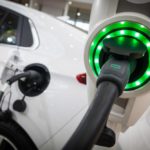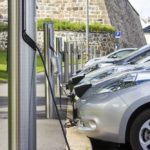Sector - Transport & Infrastructure
Driving towards new sustainability challenges

With the government investing in creating a sustainable UK in which we’ll all be living in energy-efficient new homes and driving around in electric vehicles, Chris Evans, Deputy Managing Director of engineering consultancy Rolton Group, looks at what the future holds for built environment professionals working to construct this brave new world.
As 2017 drew to a close, the government made two major announcements that are set to shape development in the UK into 2018 and beyond. Measures to boost housing production, unlock land for development and remove stamp duty barriers to boost sales to first time buyers dominated the headlines following Philip Hammond’s Budget announcement in November.
While the government has reaffirmed its commitment to achieving its new homes targets, what is less clear, however, is the way it intends to meet its commitments to tackle climate change – and this leaves us in a position of uncertainty over the future of the country’s infrastructure.
The Chancellor’s speech drew the spotlight away from the launch of its Clean Growth Strategy by the Department for Business, Energy & Industrial Strategy just six weeks before, which set out proposals for decarbonising all sectors of the UK economy through the 2020s. The document explains how the whole country can benefit from low carbon opportunities – making homes and commercial buildings more energy efficient, detailing a shift to low carbon heat sources, and paving the way for more electric vehicles (EVs) and an industrial transition to clean fuels.
These ‘clean growth’ themes were picked up by Mr. Hammond in a series of Budget policies designed to improve air quality and promote electric vehicles. Further investment was announced in EVs, charging points and a new £220M Clean Air Fund to tackle pollution hotspots in England, as well as tax increases affecting the sale of new diesel cars that do not meet latest emissions standards.
However, what was presented as “an ambitious blueprint for Britain’s low carbon future” in October 2017 became somewhat diluted by the following month. The Chancellor confirmed there would be no fresh funds for new renewable energy projects levied through electricity bills until 2025, and little detail was offered on the future of the country’s tax on carbon dioxide emissions from the power sector. The disconnect between proposal and policy has unsurprisingly left many industry professionals disappointed by the government’s lack of ambition and clarity for the UK’s low carbon future.
The sand foundations beneath the EV evolution
With the government tasking the construction industry with building 300,000 new homes a year by the middle of the next decade, developers should be asking themselves if they are fully prepared for the little-acknowledged impact EVs will have on the power supply for residential developments.
We’re already seeing changes in energy supply and demand impacting on the infrastructure development required to support this transformation in our personal transport. As a result of private investment and a sustained push from government, the UK network of EV charging points has increased from a just few hundred in 2011 to more than 12,000 today. The November Budget announcements pave the way for this network to grow further, with £400M investment committed to improving the charging infrastructure for EVs and another £100M in subsidies to encourage consumers to buy EVs.
The challenge developers face is to use new technologies, engineering, and experience to deliver smart solutions that meet the evolving needs of homeowners – and that means having a robust, future-proof energy infrastructure in place. The government has made its commitment to EVs clear through investment in related R&D, and its announcement banning the sale of solely diesel and petrol cars by 2040 means the clock is now ticking for the developers and policymakers responsible for shaping our built environment. Alarm bells have already been ringing in some quarters as consumer demand for power continues to grow. As more and more owners seek to plug in EVs to charge at home, the National Grid has warned that people may have to make a choice between boiling a kettle or charging their car. Given that the charging of vehicles will often coincide with peak usage of power within the house itself – when the resident returns home from work and they are using other devices, ie: kettles, hobs, etc – there is clearly going to be power supply issue for individual homeowners. With the potential of streets full of electric vehicle owners all plugging in simultaneously in years to come, we could see more widespread implications as our energy demands outstrip supply, including a greater likelihood of regular brownouts. This is bad news, not just for residents, but also for businesses which require greater energy security to meet the UK’s bold economic growth plans. What we need to deal with is to ensure overloading the grid does not occur because of people’s actions. For example recently, due to a gas outage, electric heaters were handed to consumers which subsequently caused the local the transformer to blow – not a positive outcome!
A sustainable solution
Forward-thinking developers are starting to work towards energy solutions that marry meeting the UK’s housing shortage with the growth in EV charging. The Greater London Authority, for example, now requires that all new housing developments include 20% active EV charge points, with an additional 20% passive capacity to allow for future connections. Progressive housebuilders have an opportunity to differentiate themselves by installing charging points at new developments – this could boost house prices and sales, raise their brand profile and help meet sustainability targets.
Furthermore, installing communal charging areas – for example, in high rise city centre developments – could also provide an ongoing source of income. In time, there is even the possibility of EV batteries using the shared facility being combined as part of an energy storage solution (Vehicle to Grid system), providing an income stream by selling energy back to the grid at periods of peak demand.
The anticipated rollout of charging points to meet the needs of the increasing number of EV owners across the UK will bring to a head a fundamental challenge in terms of availability of power. The continuing influx of EVs is set to put increased pressure on our already overloaded National Grid. Whilst theoretically, the grid’s capacity to provide the increase in power required for EVs can be facilitated in the short term, over the long term this poses more of a challenge. Furthermore, higher EV uptake in certain areas combined with lack of infrastructure investment has the potential to create imminent and significant local challenges.
One solution for developers could be the inclusion of decentralised energy generation, allowing less reliance on the UK electricity grid. Installing off-grid renewable power supply solutions, such as green waste to energy plants that utilise Advanced Conversion Technologies like gasification and pyrolysis, PV or wind turbines that would not only facilitate the power requirements for EVs (if not completely, then at least in part depending on the energy generation method selected) but would also secure future energy supply for a specific site. In addition, such renewable energy sources would go towards meeting developers’ and international environmental targets, minimise landfill and maximise renewable energy generation.
It is a particular pity, therefore, that the government chose not to take the opportunity of the November Budget to give further clarity on how it is planning to bring new renewable energy projects forward, especially for less developed technologies like tidal and waste to energy schemes. Indeed, by announcing no new support for projects post-2020 and a freeze on carbon taxes, the UK government seems to be turning its back on the renewables proposals it outlined in the Clean Growth Strategy just the month before. This lack of commitment could see a hiatus in much-needed infrastructure development, which could derail the whole plan before it even gets off the ground.
Outlook for 2018
One of the key boasts of The Clean Growth Strategy is its intention to escalate our economic growth in every sector whilst also ensuring that the UK continues to lead in the sustainable energy arena. It was quite rightly labeled as “ambitious” – and the good intentions to develop a comprehensive set of policies that aim to accelerate the pace of ‘clean growth’ are admirable.
The headlines depicting a sustainable UK in which we’ll all be living in energy-efficient new homes and driving around in electric vehicles are only looking at the tip of the iceberg. If we are to achieve the government’s aim to accelerate the pace of ‘clean growth’ – ie: deliver increased economic growth and decreased emissions – we cannot continue to ignore the infrastructure improvements required to cater for the paradigm shift in the UK’s energy landscape going forwards. Our transport, energy and communications networks are becoming increasingly and inextricably linked with developments in the built environment, and a cohesive UK-wide strategy is vital. Cross-sector collaboration between government and industry is essential to ensure the UK continues to grow and flourish in the emerging brave new sustainable world.
If you would like to read more articles like this then please click here.
Related Articles
More Transport & Infrastructure Features
- How technology can improve supply chain resilience in infrastructure project delivery
5 Apr 24
Major infrastructure projects rely on supply chains being resilient in the face of unexpected challenges.
- New report outlines highways and transportation sector employment trends
14 Mar 24
CIHT) has released a groundbreaking benchmark report that tracks employment trends.
- UK construction costs set to rise by up to 3.8% in 2024
29 Feb 24
Construction costs in the UK are predicted to rise by 3 – 3.8% this year, following an increase of 4.1% in 2023.






